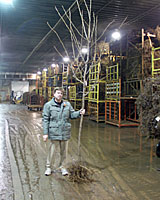Terry L. Ettinger Horticulture Consulting Services
Meeting The Needs Of Today With A Vision For The Future
Question of the Week
Autumn Shrub Transplanting
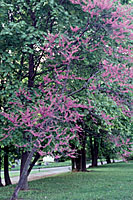 Q. We've discovered a small redbud tree growing along the back edge of our yard. We think it must have started
from a seed from our neighbor's tree?
Q. We've discovered a small redbud tree growing along the back edge of our yard. We think it must have started
from a seed from our neighbor's tree?
We're wondering if we could transplant this roughly five foot tall tree to a more prominent spot in our yard yet this fall, as we're going to be putting up a fence where it's currently growing?
A. The answer to your question is yes, absolutely! In fact, late autumn is a great time of year to transplant almost all deciduous trees and shrubs because:
- Soils are still relatively warm, which helps transplants become restablished in their new location more quickly than in early spring when soils are still icy-cold,
- Cool temperatures in late autumn place little stress on the plants,
- Because plants are dropping their leaves, they'll lose little water through the process of evapotranspiration,
- Rainfall tends to be fairly reliable, which puts less stress on you to keep plants well watered.
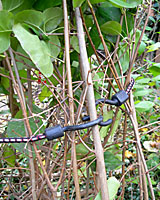 A
couple of years ago, I transplanted a couple of six foot-tall lilacs by first
bundling together their stems with bungee cords, at left. This made it much
easier to see what I was doing around the base of the plants.
A
couple of years ago, I transplanted a couple of six foot-tall lilacs by first
bundling together their stems with bungee cords, at left. This made it much
easier to see what I was doing around the base of the plants.
Next, I dug completely around each plant about a foot and a half out from their trunks (for a total root system diameter of about three feet), then drove my shovel about ten inches deep under the roots of each plant to lift them from the ground, below right.
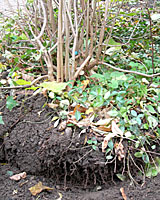 At this point, I could have simply plopped (that's a technical term, by the way) these plants right into their new home.
I took the process one step further, however, by washing all the soil from roots of the lilacs with a garden hose,
below left. I did this was because I didn't want to also transplant the vinca, English ivy and creeping Charlie growing among the
roots of the lilacs. And, without the soil around their roots, the lilacs where much easier to carry to the spot where they
were to be planted!
At this point, I could have simply plopped (that's a technical term, by the way) these plants right into their new home.
I took the process one step further, however, by washing all the soil from roots of the lilacs with a garden hose,
below left. I did this was because I didn't want to also transplant the vinca, English ivy and creeping Charlie growing among the
roots of the lilacs. And, without the soil around their roots, the lilacs where much easier to carry to the spot where they
were to be planted!
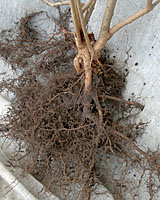 Digging dormant shade, flowering and fruit trees up to twenty feet tall, as well as deciduous shrubs,
many perennials, and small evergreen seedlings is done at many production nurseries throughout the
U.S. and Canada beginning about the middle of October each year,
below right. While some are transplanted immediately, are stored in massive refrigerated warehouses,
below left, for shipment from March through June of the following
year.
Digging dormant shade, flowering and fruit trees up to twenty feet tall, as well as deciduous shrubs,
many perennials, and small evergreen seedlings is done at many production nurseries throughout the
U.S. and Canada beginning about the middle of October each year,
below right. While some are transplanted immediately, are stored in massive refrigerated warehouses,
below left, for shipment from March through June of the following
year.
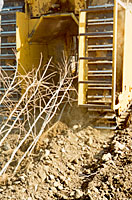 So, whether you transplant your redbud seedling with soil around its roots or in bare root form, make sure to water it
well to settle the soil around its roots. You might also want to place a hardware cloth cylinder around its trunk
to prevent
voles and rabbits from gnawing at its trunk under a deep blanket of snow this coming winter.
So, whether you transplant your redbud seedling with soil around its roots or in bare root form, make sure to water it
well to settle the soil around its roots. You might also want to place a hardware cloth cylinder around its trunk
to prevent
voles and rabbits from gnawing at its trunk under a deep blanket of snow this coming winter.
